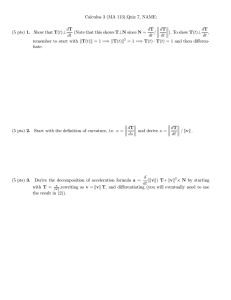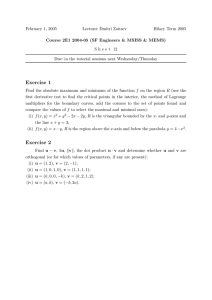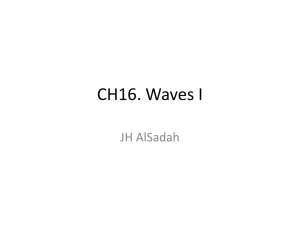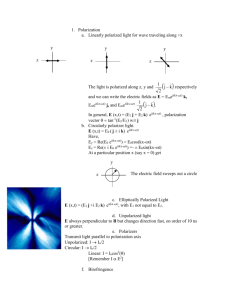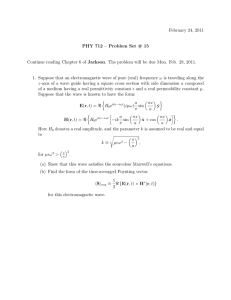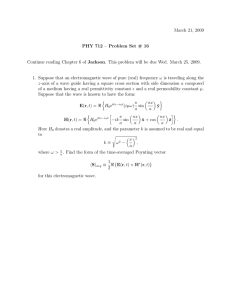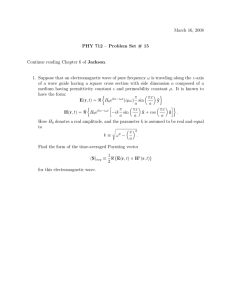Jan 14/02 Waves
advertisement
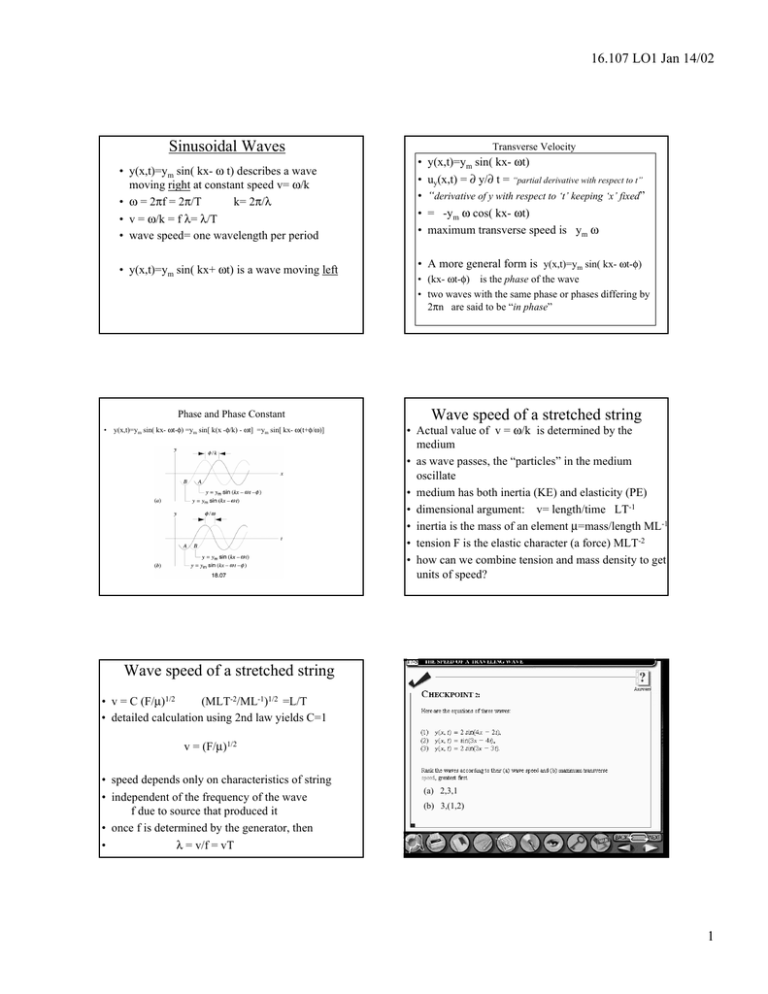
16.107 LO1 Jan 14/02 Sinusoidal Waves • y(x,t)=ym sin( kx- ω t) describes a wave moving right at constant speed v= ω/k • ω = 2πf = 2π/T k= 2π/λ • v = ω/k = f λ= λ/T • wave speed= one wavelength per period • y(x,t)=ym sin( kx+ ωt) is a wave moving left Phase and Phase Constant • y(x,t)=ym sin( kx- ωt-φ) =ym sin[ k(x -φ/k) - ωt] =ym sin[ kx- ω(t+φ/ω)] Transverse Velocity • • • • • y(x,t)=ym sin( kx- ωt) uy(x,t) = ∂ y/∂ t = “partial derivative with respect to t” “derivative of y with respect to ‘t’ keeping ‘x’ fixed” = -ym ω cos( kx- ωt) maximum transverse speed is ym ω • A more general form is y(x,t)=ym sin( kx- ωt-φ) • (kx- ωt-φ) is the phase of the wave • two waves with the same phase or phases differing by 2πn are said to be “in phase” Wave speed of a stretched string • Actual value of v = ω/k is determined by the medium • as wave passes, the “particles” in the medium oscillate • medium has both inertia (KE) and elasticity (PE) • dimensional argument: v= length/time LT-1 • inertia is the mass of an element µ=mass/length ML-1 • tension F is the elastic character (a force) MLT-2 • how can we combine tension and mass density to get units of speed? Wave speed of a stretched string • v = C (F/µ)1/2 (MLT-2/ML-1)1/2 =L/T • detailed calculation using 2nd law yields C=1 v = (F/µ)1/2 • speed depends only on characteristics of string • independent of the frequency of the wave f due to source that produced it • once f is determined by the generator, then • λ = v/f = vT (a) 2,3,1 (b) 3,(1,2) 1 16.107 LO1 Jan 14/02 Summary • ω = 2πf = 2π/T k= 2π/λ • v = ω/k = f λ= λ/T • wave speed= one wavelength per period Waves • y(x,t)=ym sin( kx- ωt-φ) describes a wave moving right at constant speed v= ω /k • y(x,t)=ym sin( kx+ ωt-φ) is a wave moving left • v = (F/µ)1/2 • F = tension µ = mass per unit length F F F/2 F/2 v=(F/µ)1/2 Wave Equation Wave Equation • How are derivatives of y(x,t) with respect to both x and t related => wave equation ∂2 y 1 ∂2 y • • • • • • ∂x 2 = v 2 ∂t 2 length of segment is ∆x and its mass is m=µ ∆x net force in vertical direction is Fsinθ2 - Fsin θ1 but sinθ~ θ~tan θ when θ is small net vertical force on segment is F(tanθ2 - tan θ1 ) but slope S of string is S=tan θ = ∂y/∂x net force is F(S2 - S1) = F ∆S = ma = µ∆x∂2y/∂t2 • F ∆S = µ∆x∂2y/∂t2 • ∆S/∆x = (µ/F)∂2y/∂t2 • as ∆x => 0, ∆S/∆x = ∂S/ ∂x = ∂/ ∂x (∂y/ ∂x)= ∂2y/∂x2 ∂2 y µ ∂2 y = ∂x 2 F ∂t 2 • any function y=f(x-vt) or y=g(x+vt) satisfies this equation with • • Energy and Power • it takes energy to set up a wave on a stretched string y(x,t)=ym sin( kx- ωt) • the wave transports the energy both as kinetic energy and elastic potential energy • an element of length dx of the string has mass dm = µdx • this element (at some pt x) moves up and down with varying velocity u = dy/dt (keep x fixed!) • this element has kinetic energy dK=(1/2)(dm)u2 • u is maximum as element moves through y=0 • u is zero when y=ym force = ma v = (F/µ)1/2 ∂2 y 1 ∂2 y = ∂x 2 v 2 ∂t 2 y(x,t)= A sin(kx-ωt) is a harmonic wave Energy and Power • y(x,t)= ym sin( kx- ωt) • uy=dy/dt= -ym ω cos( kx- ωt) (keep x fixed!) • dK=(1/2)dm uy2 =(1/2) µdx ω2 ym2cos2(kx- ωt) • kinetic energy of element dx • potential energy of a segment is work done in stretching string and depends on the slope dy/dx • when y=A the element has its normal length dx • when y=0, the slope dy/dx is largest and the stretching is maximum • dU = F( dl -dx) force times change in length • both KE and PE are maximum when y=0 2 16.107 LO1 Jan 14/02 Potential Energy • Length dl = dx 2 + dy 2 = dx 1 + (dy / dx ) 2 ≈ dx + (1 / 2)(dy / dx ) 2 dx • hence dl-dx = (1/2) (dy/dx)2 dx • dU = (1/2) F (dy/dx)2 dx potential energy of element dx • • • • • • • • y(x,t)= ym sin( kx- ωt) keeping t fixed! dy/dx= ym k cos(kx - ω t) Since F=µv2 = µω2/k2 we find dU=(1/2) µdx ω2ym 2cos2(kx- ω t) dK=(1/2) µdx ω 2ym 2cos2(kx- ω t) dE= µω2ym 2cos2(kx- ωt) dx average of cos2 over one period is 1/2 dEav= (1/2) µ ω 2ym 2 dx cos(x) cos2(x) 0. .5 3
